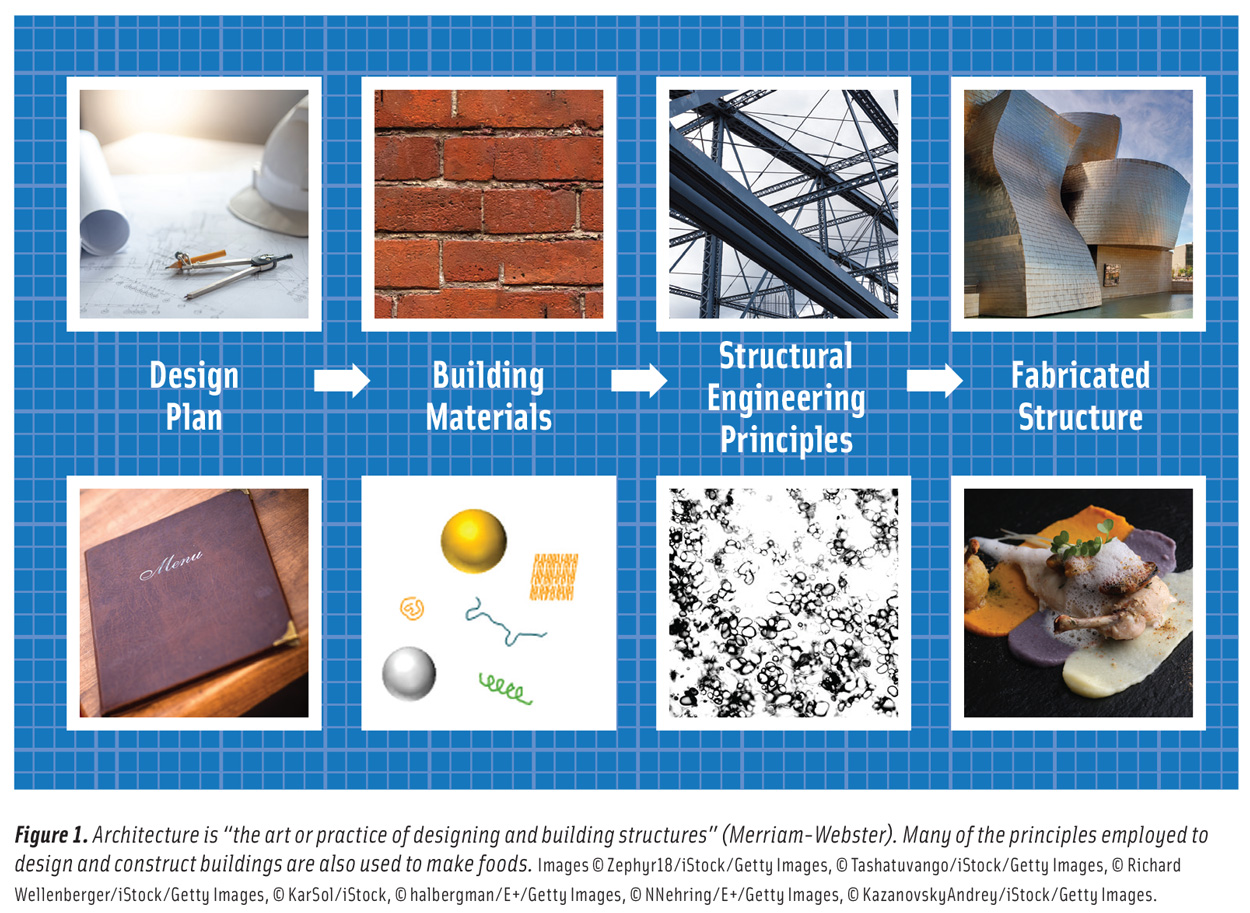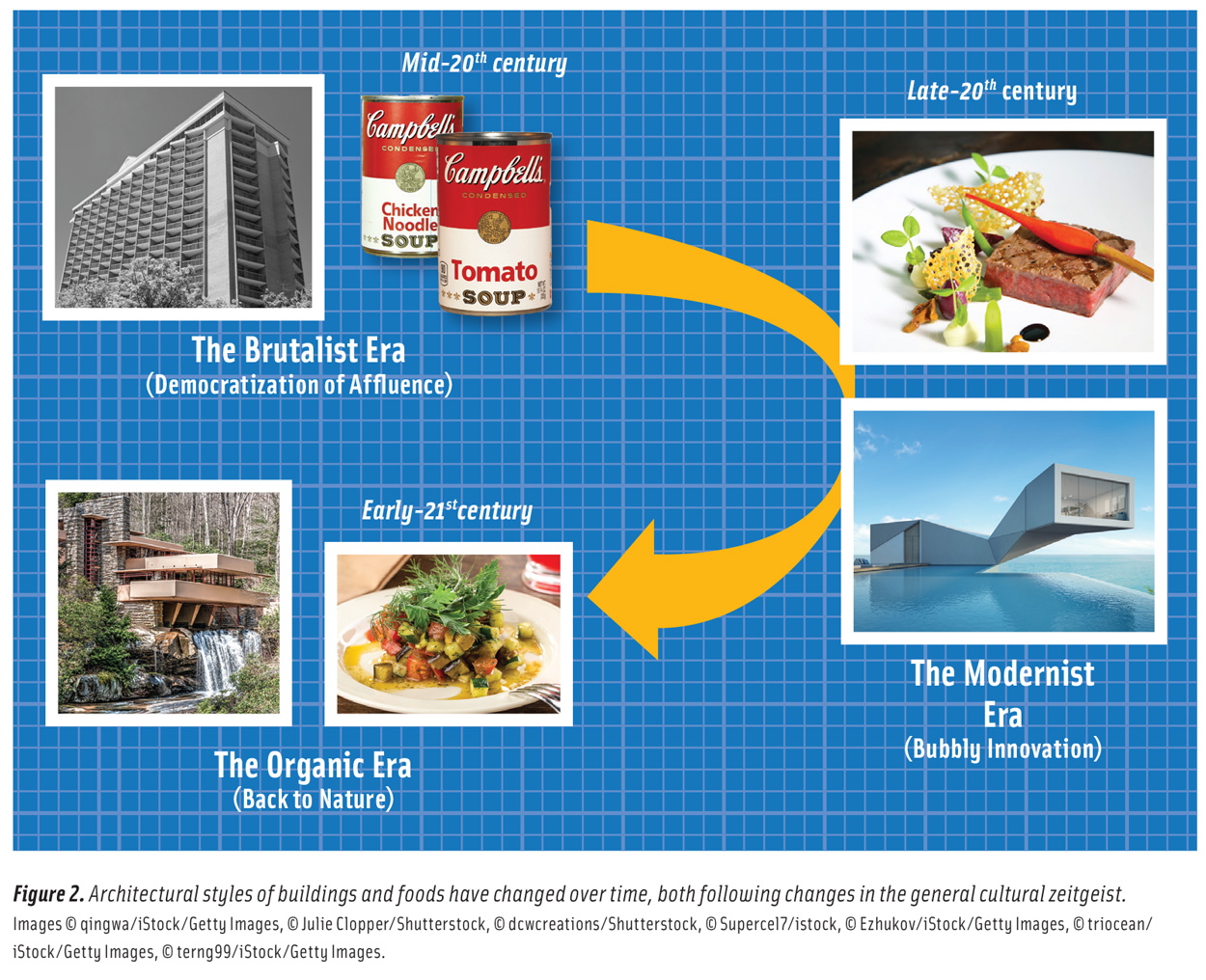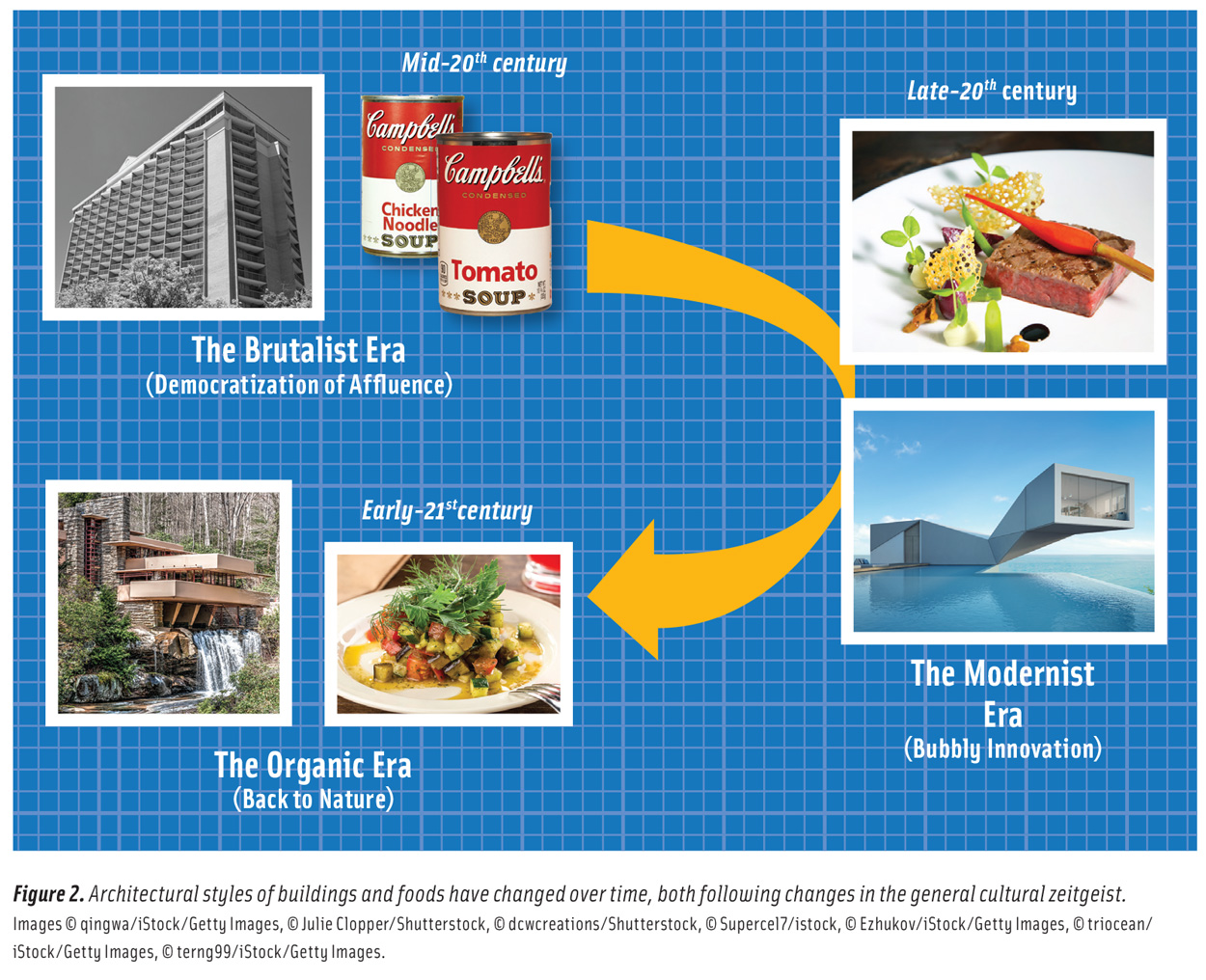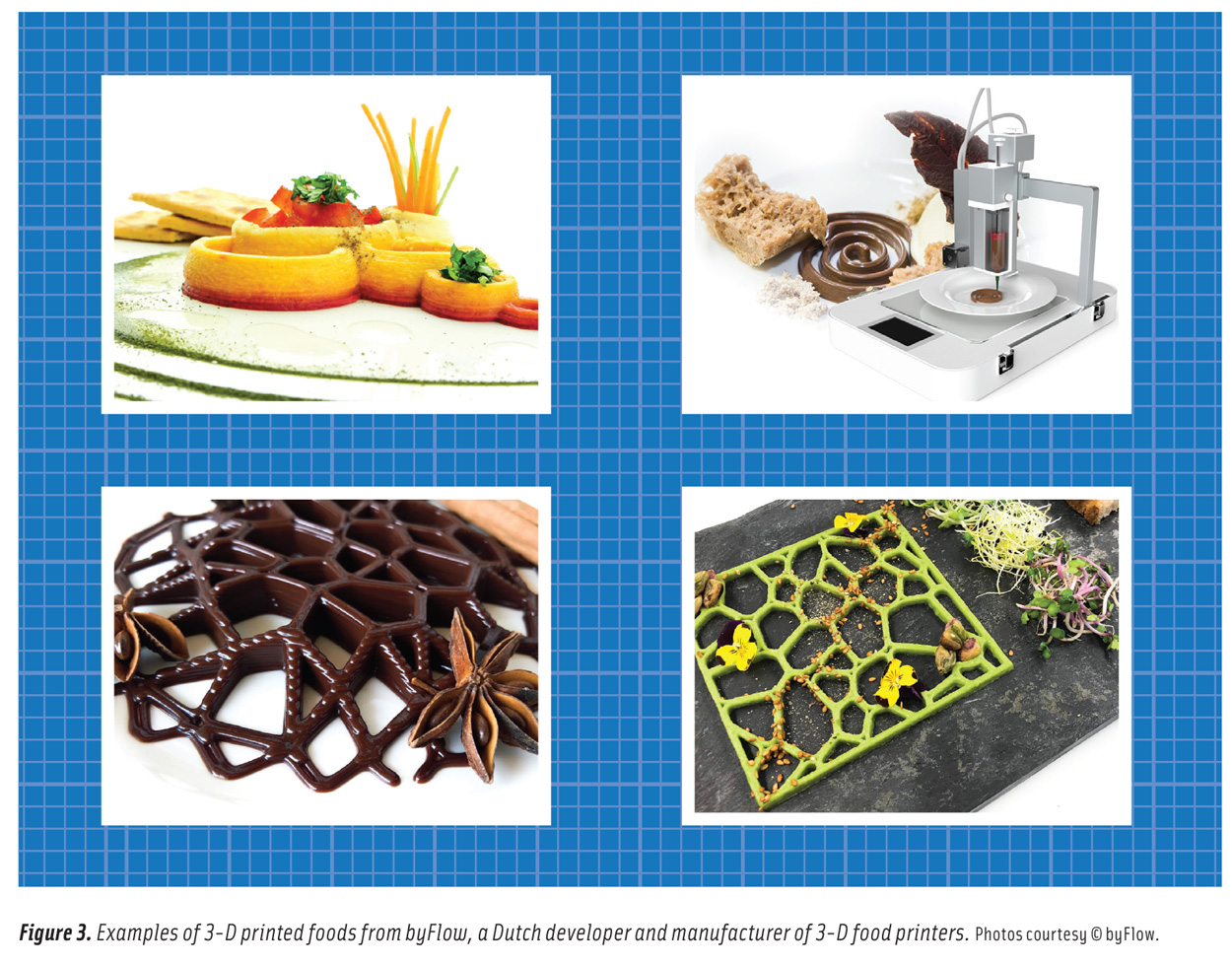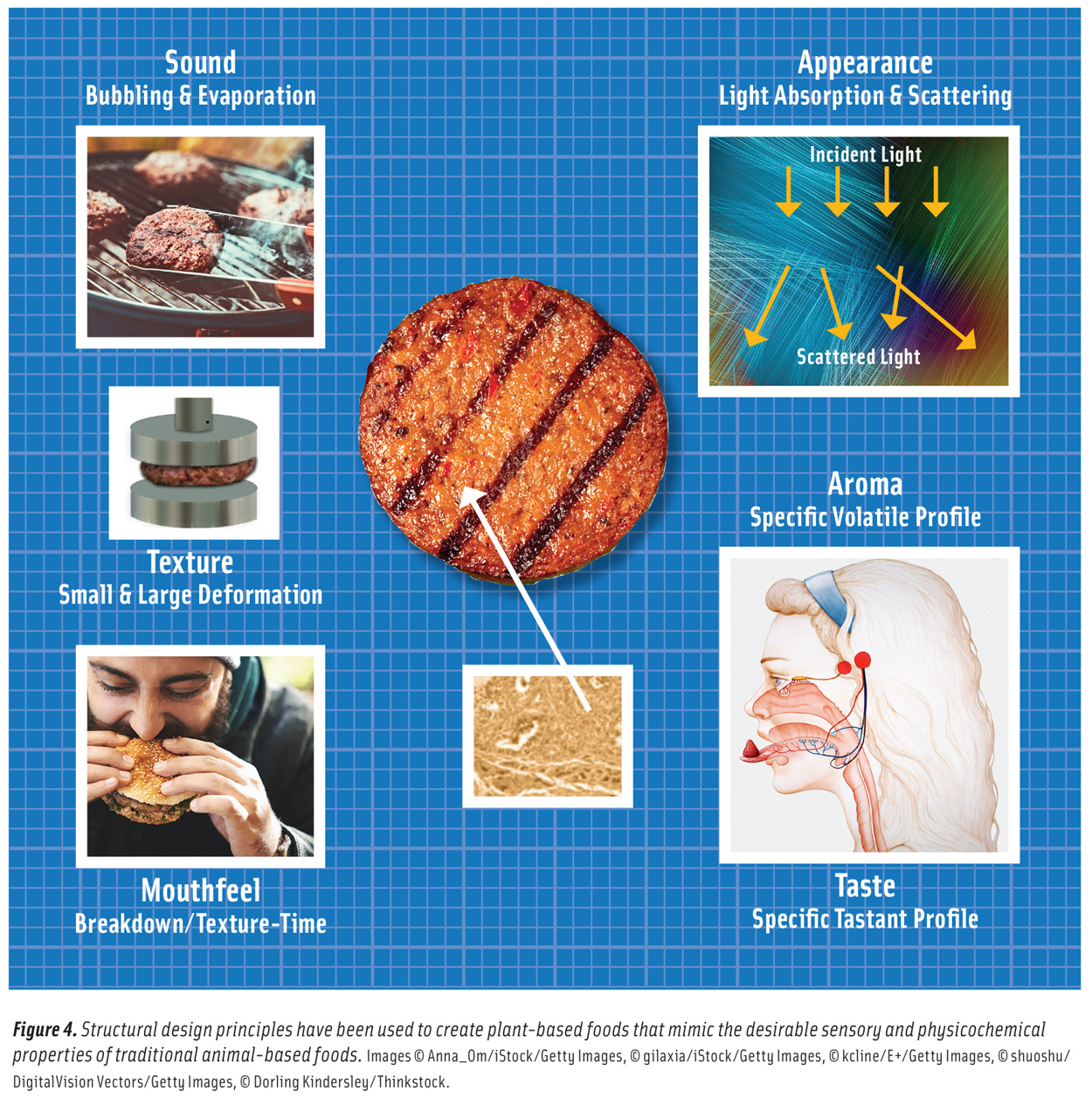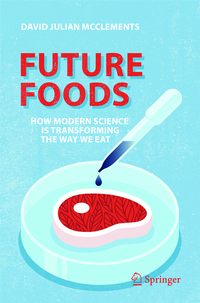
Food Architecture: Building A Better Food Supply
Food scientists are using structural design principles to improve the healthiness, sustainability, and quality of the modern food system.
Article Content
Important scientific and technological advances are being made in a broad range of areas that are transforming the way we produce and consume foods (McClements 2019). These advances are being driven by academic, industrial, and government scientists trying to tackle some of the major food-related challenges facing modern society. These challenges include feeding a growing global population without damaging the planet, tackling the alarming rise of diet-related chronic diseases in many developed countries, and combating the malnutrition that is still prevalent in some developing countries.
Current agricultural and food manufacturing practices are a major contributor to many of these problems and have been linked to the increased industrialization of the food supply. Indeed, the application of science and technology to food production is often viewed as detrimental and many people are demanding “real food” produced using more authentic and sustainable methods.
In reality, almost all of our foods are the result of the application of science and technology. The high-quality fresh fruits and vegetables available in our supermarkets come from years of selective breeding and optimization and control of harvesting, transport, and storage conditions. Our supermarket shelves are full of a diverse range of affordable, tasty, and convenient processed foods developed through the creativity and efforts of numerous scientists and engineers. The availability of these foods has given people more time and money to spend on other activities they enjoy. Nevertheless, some of the processed foods we now consume are contributing to our current health problems. Many soft drinks, dressings, sauces, condiments, confectionary, snacks, desserts, and baked goods are calorie-dense, contain high levels of saturated fats, sugar or salt, and are rapidly digested within our bodies, which may cause us health problems.
The modern food industry has largely solved the challenges associated with affordability, convenience, and taste, but they have often neglected the health and environmental impacts of their products. For this reason, many people now condemn all processed foods as bad. However, just because many of the processed foods currently available are unhealthy if overconsumed, it does not mean that processed foods per se are unhealthy. It is possible to create healthier and more sustainable processed foods by the careful application of science and technology.
Nutritionists have encouraged the public to consume more fresh fruits and vegetables, nuts, grains, and whole foods for decades, but this has done little to improve the health status of the general population. This is because many people do not have the time, resources, or inclination to prepare foods from fresh ingredients at every meal. Instead, they prefer the convenience of buying inexpensive processed foods that can quickly and simply be prepared.
Nutritionists and food activists should be encouraging the food industry to create healthier processed foods, rather than demonizing all processed foods. Moreover, food processing can lead to a decrease in food waste, thereby improving the sustainability of the food supply. Many fresh foods are thrown away because they are not used before they spoil. This problem can be overcome by converting fresh produce into processed foods, which typically have a longer shelf-life and can be used when desired, for instance, frozen, dried, or canned foods. In the future, we should design more foods that have a lower calorie density, lower environmental impact, appropriate nutrient balance, and slower digestibility. This effort will lead to a healthier and more sustainable food supply.
The following sections of the article outline some of the innovative technological solutions being developed to tackle the major food challenges facing society. In particular, emphasis is given to the concept of food architecture— the rational design of functionality from the bottom up—which is being employed in many areas. Of course, the solutions outlined here are not the only ones possible. Changes in farming practices, such as more organic farming and regenerative agriculture, are certainly important too, but the innovative technological approaches described here provide some additional tools than humankind can utilize to ensure we all have enough high-quality food to eat in the future.
Food Architecture
Merriam-Webster’s dictionary defines architecture as “the art or practice of designing and building structures”, which is usually taken to mean buildings. Conventional architects design buildings to have a particular aesthetic and function, depending on their location and intended purpose (Figure 1). The design rules for a modern skyscraper in a global financial center are different from those for a modest library in a small city. Similarly, food architecture can be defined as the “art and practice of designing and fabricating foods”. Food architects design foods to have a specific aesthetic and function depending on their intended use. The design rules for a beef bourguignon served in an expensive French restaurant are different from those of a mass-produced burger sold in a fast food chain. Both conventional and food architects have to consider aesthetics, costs, timelines, context, safety, and the properties of the available building materials.
Conventional architects use bricks, wood, metal, concrete, plastic, and glass to design and build structures with specific requirements. These building blocks are held together by cement, nails, screws, joints, welding, and glue. The architect must understand the properties of each of these materials and how they perform in the specific environment they will be used in. For instance, the ability of the building to withstand particular mechanical stresses and climate conditions (wind, rain, sunlight, temperature changes) have to be accounted for.
Food architects also use building blocks, but they are food ingredients. These ingredients may be fairly simple constituents (such as proteins, fats, carbohydrates, water, and minerals) or prefabricated materials (such as eggs, milk, meat, flour, cereals, nuts, vegetables, and fruits). Food architects must understand how to assemble these ingredients into specific structures, which involves an understanding of the forces holding them together and of structural design principles (Figure 1). These forces include things such as van der Waals, electrostatic, hydrophobic, and hydrogen bonding interactions, as well as gravity. The structural design principles include phenomenon such as chemical transformations, phase separations, phase transitions, conformational changes, complexation, and binding. A good food architect will have a toolbox of knowledge that includes a detailed understanding of the building blocks, molecular cement, and structural design principles of foods.
Historical Trends in Architecture
The design trends in food architecture often parallel those in conventional architecture (Figure 2), presumably because they both reflect changes in the zeitgeist of the surrounding culture. In the mid- 20th century, there was a proliferation of brutalist concrete structures, especially tower blocks, shopping centers, and university buildings. At the same time, there was a proliferation of brutalist processed foods, such as TV dinners, sliced bread, meat spreads, and powdered drinks. The brutalist architectural movement put affordability and function over exclusiveness and ornamentation. The technological innovations underpinning the brutalist movement led to cheaper and more widely available mass-produced foods and homes, but often at a cost of a reduced connection to our environment.
At the end of the 20th century, architects inspired by postmodernism created unique buildings that defied our expectations of form and function, including Frank Gehry’s Guggenheim Museum in Bilbao (Figure 2). Around the same time, food architects inspired by molecular gastronomy created edible structures that challenged our expectations by using unusual ingredients or processes. These exquisite buildings and foods may have reflected deeper changes in society where a new class of affluent individuals were trying to distinguish themselves from the past. It is interesting that the swirling forms of post-modern architecture and the creamy emulsions and airy foams of molecular gastronomy both flourished in a period of conspicuous consumption as the financial markets frothed.
The economic crisis of 2008 led to another change in architectural styles. There was an increasing emphasis on the creation of more “authentic” foods and buildings using locally sourced organic materials, reflecting the zeitgeist of these more austere times. Many modern architects are constructing more sustainable and organic buildings using local materials, just as many restaurant chefs are creating more sustainable and organic meals from local ingredients.
Another architectural style that has been adopted recently by both the construction and food industries is additive manufacturing (Figure 3). Large 3-D printers are being used to create custom-built buildings, whereas smaller versions are being used to create innovative foods. 3-D printers are becoming more affordable and versatile, so their application is likely to continue to increase.
As cultural trends change, it seems likely that food design and architecture will continue to exhibit parallel styles, sometimes more traditionalist, sometimes more modern, sometimes more ornate, sometimes more functional. An important lesson from this history is that what we now think is fixed, will almost certainly change in the future. This provides opportunities for the food industry to develop innovative products. But it also means that they must be careful to keep up with any emerging trends within the broader society and be ready to respond. In the remainder of this article, the food architecture approach is highlighted with some specific examples.
The Architecture of Deliciousness
If we are going to create a new generation of healthier and more sustainable processed foods, then it is critical that they taste delicious or no one will buy them. There has been great progress in understanding what makes foods taste delicious over the past few decades, which is being used to design tastier and more desirable food and beverage products. Food scientists are employing modern analytical tools, such as mass spectrometry, gas chromatography, NMR, and electronic noses, to measure the dizzying array of flavor molecules within specific foods. This “flavorome” consists of volatile aroma and nonvolatile taste molecules, as well as other substances that elicit different specific perceptions in our mouths, such as trigeminal and mouthfeel sensations.
Food engineers, physical chemists, and sensory scientists are increasing the understanding of how foods breakdown in our mouths and release the flavor molecules they contain so that they can reach our flavor receptors and stimulate them. This requires knowledge of flavor intensity-time profiles and how they are influenced by food matrix effects. Physiologists and biochemists are working out the molecular details of the various flavor sensors in our noses and mouths, as well as in other parts of our body. Moreover, they are elucidating how our hormonal and nervous systems create physiological responses to specific foods in our bodies and brains. Some food companies are integrating this diversity of knowledge to build products with compositions and structures that are perceived as being delicious by consumers, while also being healthier and more sustainable.
The Architecture of Dissolution
In the past, food scientists were usually concerned with developing food processing operations that could build structures within foods that made them look, feel, and taste good. More recently, they have been concerned with developing innovative foods that breakdown in a controlled way inside the human gut after they have been ingested. For instance, there has been interest in generating specific compositions and structures within the gastrointestinal fluids after a food has been digested, since these factors can increase the bioavailability of beneficial nutrients, such as minerals, vitamins, and nutraceuticals. Moreover, the rate and location of food digestion inside the human body is being controlled to manipulate the time response of metabolites entering the bloodstream (such as glucose or lipids), as well as to control the release of hormones (such as those related to hunger and satiety). These structural design principles are being used to create foods that prevent chronic diseases such as diabetes or heart disease or that can reduce overeating, thereby preventing obesity.
Cellular Architecture
Since the elucidation of the structure of DNA in the 1950s, there have been incredible advances in biotechnology, many of which are now being applied to improve our food supply. These new technologies typically involve tinkering with the cellular machinery inside living organisms to create new foods or food ingredients, or to improve the performance of existing ones. Biotech is being used to alter edible species, such as plants, animals, or microbes, or the substances they produce such as enzymes, flavors, preservatives, nutrients, or nutraceuticals. Alternatively, the cellular machinery may be reprogrammed to carry out new functions, such as fixing nitrogen in agricultural crops or cleaning up the environment. In these cases, scientists are using their knowledge of the internal architecture of cells to create new substances and functions.
A few select examples of the application of modern food biotechnology for improving our food supply include:
• Clean meat: A growing number of companies have adopted tissue engineering techniques developed by biotechnologists to grow meat in a laboratory from a few cells taken from a live animal. This clean meat technology is being scaled up to produce meat products in amounts that could significantly reduce the number of animal products consumed, which could have major environmental, sustainability, and ethical benefits. For instance, clean meat does not involve the largescale rearing and slaughter of animals, it requires less land and water, causes less pollution, and does not lead to antibiotic resistance.
• Cellular agriculture: Many food companies are using biotechnology to produce functional food ingredients from microbes grown in fermentation tanks. For instance, enzymes, hormones, vitamins, nutraceuticals, flavors, and other functional ingredients can be produced in large quantities using this method. Typically, these methods involve identifying and then generating a specific sequence of DNA to produce the desired molecule. This DNA fragment is then incorporated into a plasmid that is inserted into a microbe (typically a specific yeast or bacteria strain). Under optimized fermentation conditions, the microbe pumps out the required molecule, which can then be isolated, purified, and converted into a functional ingredient. This technology has recently been used to produce the proteins normally found in milk and egg, without the need of any animals. These proteins can then be used to create milk and egg products that have similar properties to those obtained from animals. Again, these products may reduce our reliance on animal-based foods, leading to environmental and sustainability benefits.
• Genetic engineering: There have been major advances in the ability of scientists to precisely manipulate the genes of animals, plants, and microbes, especially using CRISPR and other recently developed gene editing technologies. These new techniques are being used to improve our food supply and make it more resistant to the problems of global warming. For instance, genetic engineering is being used to increase yields, improve resilience, reduce waste, enhance nutritional value, and broaden the diversity of agricultural crops and livestock. Genetically engineered foods are currently perceived negatively by many consumers, but this technology has many potential benefits that will help us address our pressing future food needs.
Nano-Architecture: Building Foods From the Bottom Up
Nanotechnology is another controversial modern technology with great potential to improve our food supply, but that also has a negative perception by some consumers. Nanotech principles can be used to build innovative food materials from the bottom up that have new or enhanced properties and performances.
Richard Feynman, who won a Nobel prize in Physics, is usually considered to be the father of nanotechnology. In 1959, he presented a seminal lecture ‘‘There’s Plenty of Room at the Bottom’’ at the American Physical Society meeting in California. His presentation introduced the concept of rationally designing and fabricating innovative materials and machines, such as ultrasensitive microscopes, miniscule electronics, or tiny machines, by manipulating matter at the nanoscale. It was not, however, until the 1980s, that nanotechnology really became recognized as a specific scientific discipline due to the publication of a number of popular articles and books by Eric Drexler who was then working at MIT (Cambridge, MA). He wrote on the potential of using “molecular technology” to create new nanoscale materials that would transform many aspects of our world, including medicine, energy, computing, transport, and communications.
The first scientific papers on food nanotechnology were only published at the beginning of the current century, but this area has grown rapidly since then. Food nanotechnology has great potential for transforming many aspects of the foods we eat. In general, it involves understanding and controlling the structure of foods at the nanoscale, which is typically taken to extend from about 1 to 1,000 nm. A number of important applications of food nanotechnology have already shown great promise and many more are likely to arise in the near future. A few select examples include:
• Food fortification: One of the most successful applications of nanotechnology has been in the development of tiny particles to encapsulate, protect, and deliver bioactive food components, such as vitamins, minerals, nutraceuticals, and antimicrobials. The major advantage of using nanoparticles for this purpose is that delivery systems can be created that are highly stable to aggregation and gravitational separation. Moreover, the nanoparticles can be designed to be so small that they do not scatter light and so the system looks transparent, which is important for clear beverages (such as vitamin waters). Finally, tiny particles are typically digested and absorbed more rapidly in the human gut, leading to an increase in their bioavailability.
• Nano-fertilizers and -pesticides: A substantial amount of conventional fertilizers and pesticides applied to agricultural crops is currently lost to the environment, thereby polluting land and water resources. Nanotech has the potential to create a new generation of more efficient and smarter fertilizers and pesticides. For instance, miniscule versions of these materials are being developed to penetrate into plants more easily or attach to their surfaces, thereby increasing their efficacy and reducing losses.
• Packaging: Nanotechnology is being used to create innovative packaging materials to protect foods from physical, chemical, and biological damage. Moreover, nanotech is being applied to create smart packaging that provides information about the status of a food, such as its freshness or contamination, and then responds accordingly. The mechanical strength, barrier properties, and optics of packaging materials can be improved by incorporating nanostructures inside them, such as nanoparticles or nanofibers. Nanotech is also being utilized to convert waste materials, such as nanocellulose, into biodegradable packaging materials, thereby reducing our reliance on plastics made from fossil fuels.
• Filtration: There is increasing stress on the supply of fresh water for agricultural and human use. Innovative filter technologies are being developed using nanotech, which typically employ nanofibers. Nanofibers have an extremely high surface-to-volume ratio, allowing them to effectively remove unwanted materials from water. Typically, the nanofibers are packed into a filter cartridge through which the water is made to flow. These new technologies will be critical for generating clean and safe drinking water, especially in regions where water scarcity is a problem.
Sustainable Architecture
One of the most successful commercial applications of the principles of food architecture is in the plant-based meat area. Companies such as Impossible Foods and Beyond Meat have used structural design principles to create plant-based meat substitutes with many of the desirable physicochemical and sensory attributes of real meat products. This requires an understanding of the relationship between the composition and structural organization of these products on one hand, and their look, feel, smell, taste and sound on the other hand (Figure 4).
Products like the Impossible Burger are a testament to how food design principles can make a real impact on global food problems by reducing the negative environmental impacts of animal-based foods (Poore and Nemecek 2018, Willet et al. 2019). Despite being processed, these products are affordable, tasty, and convenient, as well as being more sustainable, environmentally friendly, and ethical than the meat products they are designed to replace. I believe that they should serve as an inspiration to food scientists who want to use their knowledge to have a positive impact on the world.
R E F E R E NC E S
McClements, D.J. 2019. Future Foods: How Modern Science Is Transforming the Way We Eat. New York, NY. Springer Scientific.
Poore, J. and T. Nemecek. “Reducing Food’s Environmental Impacts through Producers and Consumers.” Science. 360, no. 6392 (Jun 2018): 987-992.
Willett, W., J. Rockstrom, B. Loken, M. Springmann, T. Lang, S. Vermeulen, T. Garnett, et al. “Food in the Anthropocene: The Eat-Lancet Commission on Healthy Diets from Sustainable Food Systems.” Lancet. 393, no. 10170 (Feb ): 447-2019492.


